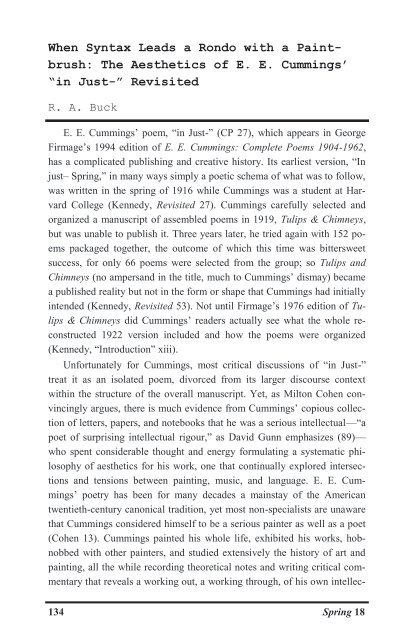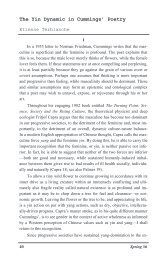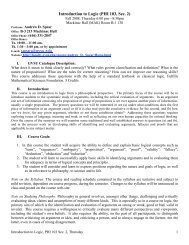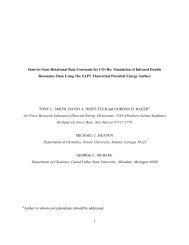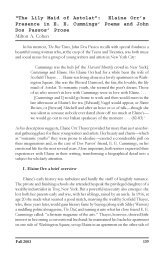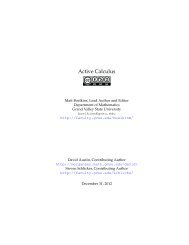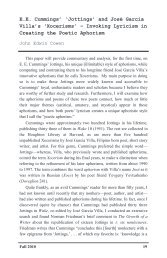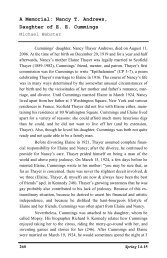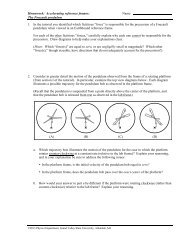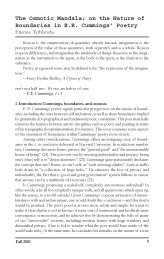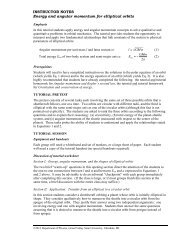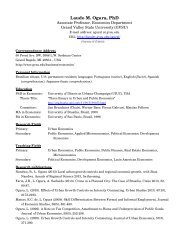The Aesthetics of EE Cummings' âin Just-â - Gvsu
The Aesthetics of EE Cummings' âin Just-â - Gvsu
The Aesthetics of EE Cummings' âin Just-â - Gvsu
- No tags were found...
Create successful ePaper yourself
Turn your PDF publications into a flip-book with our unique Google optimized e-Paper software.
love that was praised was ideal love, perfect love, with a focus on unattainabledesire. <strong>The</strong> headings “Orientale” and “La Guerre” recall for us theinterests <strong>of</strong> the troubadours and the subjects they sang about: with an interestin the Crusades, the songs <strong>of</strong> the troubadours looked to the east, theOrient, because the warriors returning from battle had stories to tell <strong>of</strong> anew culture unfamiliar to those who remained at home, and so the troubadoursrecounted and recreated these stories. Even though full <strong>of</strong> allusions toclassical Roman and Greek mythology, the poems in “Songs,” Cummings’third heading in TULIPS, function to evoke specifically English poetic andmusical—mostly Medieval and Renaissance—traditions. So we see thatCummings evokes older established traditions from Greece, Rome, France,and England to place himself and his work within these larger contexts butalso to break away from them; he shows continuity with the past but alsobreaks past traditions. He is the modern American poet-musician who isnow singing in very different ways and recounting new, timeless storiesthat simply continue the ceaseless motion <strong>of</strong> artistic creation. “Puella Mea”emphasizes that all the ladies idealized by poet-musicians throughout literaryhistory across time and space are all dead while the beauty <strong>of</strong> his lady isnow very much alive. <strong>The</strong> heading <strong>of</strong> the seventh title in TULIPS,“Amores,” recalls Ovid’s Amores, poems that speak <strong>of</strong> love and war (asCummings does in several poems in “La Guerre”) and also characterize theerotic attraction between the poet and his puella.<strong>The</strong> little poem, “in <strong>Just</strong>-”, then, one <strong>of</strong> Cummings’ most popular, mostloved, and most anthologized poems, is found in the almost-middle <strong>of</strong> theTULIPS section, immersed within these musical and poetic references,following already much mention <strong>of</strong> love, the seasons, and cyclic timelessness.<strong>The</strong> treatment <strong>of</strong> love recalled so far has been in conventional, formal,courtly, respectable, stylized artistic vehicles. It is important to note,though, that many <strong>of</strong> the songs <strong>of</strong> the troubadours and trouvères wereopenly sensual (Grout 60-61). <strong>The</strong> French chanson, which appeared later inFrance in the fourteenth and fifteenth centuries and blossomed in the sixteenthcentury, continued this secular song tradition. Important musicalcenters developed in Burgundy at the courts <strong>of</strong> the Dukes <strong>of</strong> Burgundy andin Paris at the courts <strong>of</strong> the Kings <strong>of</strong> France, and the chanson became afavored genre <strong>of</strong> the period (Machlis and Forney 108). In fact, the Frenchchansons were every popular (Grout and Palisca 165). Like the troubadoursand trouvères <strong>of</strong> the late thirteenth century, these poet-musiciansperformed courtly love poems that were set to music in a variety <strong>of</strong> fixed138 Spring 18
forms, the structures <strong>of</strong> which became freer in the sixteenth century, allowingfor more altering and rearranging <strong>of</strong> instruments (Machlis and Forney108; Grout and Palisca 165). But the French chanson tradition <strong>of</strong>feredsomething a little different that Cummings, by invoking it at this point inthe manuscript, plays around with. For even though the chansons arecloaked in courtly respectability, the poet-musicians <strong>of</strong> the time had funwith their songs: we find a wide selection <strong>of</strong> moods among the songs, but<strong>of</strong>ten they are naughty, even lusty and erotic, sometimes irreverent, sometimesfilled with sensuous longing, in addition to being simply (and innocently)amorous (Boyden 155).More specifically, the French chanson <strong>of</strong> the fourteenth and fifteenthcenturies was a musical setting <strong>of</strong> a French secular poem that was <strong>of</strong>tenwritten in any one <strong>of</strong> a variety <strong>of</strong> fixed poetic forms, such as a ballade orvirelai or rondeau. <strong>The</strong> musical setting <strong>of</strong> the rondeau, a popular example<strong>of</strong> a forme fixe, involved a refrain with a repetition scheme <strong>of</strong> two distinctmusical phrases (Grout and Palisca 135). A very simple early rondeau formmight have an ABaAabAB structure, where the capital letters represent twodistinct musical phrases <strong>of</strong> a textual refrain, each repeating at various pointsin the song with the identical corresponding text <strong>of</strong> the refrain. <strong>The</strong> lowercase letters represent a repeated musical phrase but with different words(Davison and Apel 17). <strong>The</strong> later French chanson <strong>of</strong> the sixteenth-centurybroke away from the constraints <strong>of</strong> the fixed forms and attempted to createnew shapes rather than just imitate traditional structures (Grout and Palisca17).By the time he was a student at Harvard, Cummings was already veryfamiliar with the poetic verse forms used by French poets. In 1909, he hadreceived a gift from his uncle, <strong>The</strong> Rhymester: or, <strong>The</strong> Rules <strong>of</strong> Rhyme byTom Hood, which Cummings studied carefully: he soon started to practiceits principles by creating his own little rondeaus, ballades, villanelles, triolets,and other French lyrical forms (Kennedy, Dreams 44). While a studentat Harvard during his sophomore year, he extended this practice in a lyricpoetry course with the help <strong>of</strong> the textbook, English Verse: Specimens IllustratingIts Principles and History by Raymond Macdonald Alden(Kennedy, Dreams 64).But even though Cummings’ heading, “Chansons Innocentes,” recallsfor us this earlier musical tradition <strong>of</strong> the French chanson, in typical Cummingsfashion, he does not give us what we might expect: one <strong>of</strong> theseverse forms in the first poem we encounter under the heading. Instead, weFall 2011 139
get a poem, “in <strong>Just</strong>-”, that strikes us as extremely musical, with repetition<strong>of</strong> elements at every turn, and with an apparent refrain that hints ever-soslightly<strong>of</strong> a possible rondeau, but a poem that clearly is not a rondeau. <strong>The</strong>poem has more than thirteen lines, does not have a rigidly fixed ordering <strong>of</strong>only two rhymes, and even the placement <strong>of</strong> the refrain is not quite right.When we first read the poem, we are struck by its simplicity—in lexicalitems, in grammatical structures, in its enjoyment <strong>of</strong> spring. But a detailedstructural analysis <strong>of</strong> the poem actually reveals Cummings’ genius in hisoverall conception <strong>of</strong> the interaction between syntactic form and musicalform, a complexity in texture that we feel intuitively is part <strong>of</strong> the piece butis not at first glance readily discernible.“In just-Spring,” the earliest draft <strong>of</strong> the poem (found in Kennedy, Revisited27), shows the younger poet not yet fully aware <strong>of</strong> the grammaticalstructural and typographical ambiguities available to him that he soon afterwardswould explore and implement, particularly in relation to capitalizationand punctuation. <strong>The</strong> five commas and the two periods in the earliestversion change everything for the poem, for they keep the poem at a superficiallevel without grammatical ambiguity or structural texture. In the finalversion, Cummings releases and frees up all capitalization except for in oneword, “<strong>Just</strong>-”—in the first version, twenty-three words are capitalized. It isthe eventual freeing up <strong>of</strong> all punctuation in the final version that allowshim to create the amazingly rich syntactic structural ambiguities which endup producing a rich musical texture.So rather than providing us with a fixed French medieval verse form,Cummings, as Lane suggests (28), produces a musical rondo form in structureinstead. <strong>The</strong> heading, “Chansons Innocentes,” evokes a far-in-the-pastchanson tradition, but Cummings then moves us forward and brings usrather to a poem that more closely resembles a later instrumental musicaldevelopment. <strong>The</strong> rondo was developed by French composers during theClassical period, beginning in the seventeenth century, and was an instrumentalreflection <strong>of</strong> an interest in a refrain (repeated statements) with alternatingdigressive material. Wallace Berry points out a “clear analogy betweenthe rondo . . . and that type <strong>of</strong> song which alternates between stanzaand refrain” (106).A simple classical rondo form normally has a refrain that begins therondo and reappears two more times after contrasting passages called“episodes” (Green 150). A rondo is typically light, gay, and dance-like incharacter, and the refrain is melodious and tune-like (Green 130). Unlike140 Spring 18
the older rondeau, the classical rondo form included transitional materialthat allowed for continuity between units so that the episodes could leadsmoothly back to the recurring statement (the refrain) (Green 153). <strong>The</strong>reare a number <strong>of</strong> different designs a rondo form can take, but a simple rondoscheme might have the following form: ABACAB, where A is the refrain,B are digressive episodes built <strong>of</strong> the same material that repeat, and C isfurther contrasting episodic material (Green 153; 159).Gary Lane identifies a five-section ABABA musical rondo schemebased on the thematic material <strong>of</strong> “in <strong>Just</strong>-”: the A section, the rondotheme, evokes spring, the world, and the balloonman, while the B episodesfeature the contrasting “tumble <strong>of</strong> children” (28). This paper changesLane’s identifying line numbers (he does not account for lines 23 and 24 <strong>of</strong>the poem), changes section boundaries, and develops his ideas further.Extending Lane’s ABABA general rondo scheme, this paper proposesthe following more detailed five-section musical form: ABA´B´A´´. In thisnotation, a letter followed by the prime symbol (´) indicates repetition withsome variation. <strong>The</strong> phrases within each <strong>of</strong> the sections have the followingmusical form, explained below:ABabcA´ a´b´c´B´A´´ a´c´´.In a musical sense, section A (lines 1-5, 8 end-13, and 16-24), consists <strong>of</strong>tones (lexical items) which exist in relation to musical phrases(grammatical constituents), and in relation to a melody (thematic material).<strong>The</strong> tonal center or tonic <strong>of</strong> the A sections is noticeable in the phrase “farand wee.” If we understand “far and wee” as musically in the tonic key, wecan explain why it feels like the place where we relax slightly each time itoccurs, the place where we come home to each time the section is repeated.<strong>The</strong> way that the melody moves, proceeds, progresses, and arrives towardthe tonic is called the cadence.A (Lines 1-5)A, the rondo theme, begins with the first musical phrase (a), “in <strong>Just</strong>- /spring,” which evokes spring, another musical phrase (b) which evokes theworld (as “mud- / luscious”), and a third phrase (c) about the balloonmanFall 2011 141
(he is “little” and “lame”). <strong>The</strong> last phrase (c) ends on the tonic (“far andwee”) but a transitional form in line 6 (“and”) quickly leads us to the contrastingepisode.B (Lines 6-8)B, the first episode, is a contrasting idea to A because it is about runningchildren (their names, that they are running, and what they are runningfrom). A transitional form in line 8 (“and”) takes us back to the rondotheme.A´ (Lines 8-end to 13)<strong>The</strong> end <strong>of</strong> line 8 begins the restatement <strong>of</strong> the rondo theme. <strong>The</strong> firstmusical phrase in this repeated section is (a´) rather than (a) because thephrases are not identical—some <strong>of</strong> the words have changed (i.e., “<strong>Just</strong>-”and “in” are omitted; other words are new). <strong>The</strong> next musical phrase is a(b´) because if also shows a slight variation from b (“puddle-wonderful”).<strong>The</strong> same thing happens in (c) which is now (c´); the balloonman is “queer”and “old”). At the end <strong>of</strong> c´ we arrive once again in the tonic key in therestated little, “far and wee.” A transitional form (“and”) in line 14 leads usto the next episode.B´ (Lines 14-15)<strong>The</strong> B´ episode carries the same thematic material as B, but there is avariation in the lexical forms while the grammatical forms remain thesame: the names <strong>of</strong> the children are different, the children are dancing instead<strong>of</strong> running, and the games they dance from are different. A transitionalform (“and”) in line 15 leads us back to the rondo theme.A´´ (Lines 16-24)We return for the third time to the statement <strong>of</strong> the rondo theme, but thefirst musical phrase is now (a´) rather than (a) because the phrase is identicalto the first phrase in section 2 but different from the first phrase in section1. This section is A´´ because now there are only two rather than threemusical phrases within it. <strong>The</strong> second musical phrase (b) is not restatedhere; its omission is replaced by a phrase extension (“and”) whichsmoothes over the missing phrase and so facilitates (a´)’s movement to c´´(the balloonMan who is “goat-footed”). <strong>The</strong> A´´ section (and thus thewhole rondo) ends on the tonic with the little restated phrase “far and wee.”Much has been said (especially by Cohen) <strong>of</strong> Cummings’ placement <strong>of</strong>words on the page and how these visual aspects create musical effects inthis poem, so I will not reiterate those elements here. But we do, <strong>of</strong> course,note that the five sections above are not neatly divided by verse line but142 Spring 18
ather run into each other and cross over line boundaries, thus creating evenmore interesting visual and musical effects. So Cummings exploits anddevelops a variety <strong>of</strong> structural levels within his poems: visual and organizational(how words appear on the page); thematic (what the words say);musical (how language is patterned thematically); and finally, syntactic(how grammatical choices are made to create musical effects).Before moving to the large syntactic infrastructure <strong>of</strong> the overall poem,we can notice that simply at the small local lexical level, the poem showsmuch repetition. <strong>The</strong> poem repeats exactly the same words mostly in the(b) and (c) phrases <strong>of</strong> the A sections: in (b), out <strong>of</strong> six words, only two aredifferent; in (c), out <strong>of</strong> 8 words, six repeat. <strong>The</strong> same number <strong>of</strong> words appearin (a) in all three A sections and are identical words in the last two Asections. I am counting elements <strong>of</strong> a compound structure separately, so Bshows a slight increase <strong>of</strong> words (by 2) in the second episode; if compoundsare considered one element, they show an identical number <strong>of</strong>words. In B, function words are identical, and lexical categories are exactlythe same, but the words that fill in the lexical categories are different. Inspite <strong>of</strong> all this repetition at the lexical level, only two grammatical constituentsare identical in their lexical repetition: “it’s spring” twice in therefrain and “far and wee” all three times in the tonic). In addition, it is whatCummings does visually with constituent structure that <strong>of</strong>ten refuses toallow repetition to be exact repetition. Grammatical constituents are dividedup on the poetic line, in other words, in different places, or exist inrelation to other constituents on the same line in different ways, thus creatingdifferent rhythmic effects. For example, the “balloonman” phrase insection A is a noun phrase (“the little / lame balloonman”) distributed overtwo lines but exists in relation to the preceding musical tone from the precedingconstituent structure, “luscious.” In A´, the same constituent is distributedover two lines but this time in relation to the subsequent constituent,“whistles.” In A´´, the noun phrase is distributed over three lines, theheadword (“balloonMan”) separated from its modifying determiner (“the”)and adjective (“goat-footed”) and is separated in distance on line 21 fromthe subsequent constituent.But Cummings’ little poem here is musically even more complex thanthis when we examine the way larger syntactic structures and rondo forminteract and collide with each other. If we chart out the syntactic structure<strong>of</strong> the poem we can see that, by way <strong>of</strong> analogy, the syntax provides acounterpoint and that a textural process occurs with the thematic rondoFall 2011 143
form (textures moving against one another) so that each texture is heard asseparate and distinct yet as one thing all at the same time. <strong>Just</strong> as the musicalrondo is all about stating, ending, digressing, and then stating again, thesyntax is creating its own beginnings and ends, leading us in artful syntacticcadences that at some points avoid being cadences and thus pick up allover again. <strong>The</strong>se textures are at times occurring at cross-rhythm with eachother.<strong>The</strong> syntactic structure <strong>of</strong> Cummings’ poem is primarily developedaround the simple concepts <strong>of</strong> coordination and subordination. Cummingsuses the connective form, the coordinating conjunction “and,” to functionmusically in a variety <strong>of</strong> ways. <strong>The</strong>re are twelve occurrences <strong>of</strong> the word“and” in the poem. Cummings uses it to join small phrasal categories: nounphrases (“eddieandbill;” “marbles and / piracies;” “bettyandisbel” “hopscotchand jump-rope”) and an adverbial phrase (“far and wee”; “far andwee”; “far / and / wee”). As we have seen in the rondo section, “and” als<strong>of</strong>unctions as a transitional form to move smoothly and continuously fromone clause to another, for the coordinating conjunction also connects thesentence as phrasal unit, so when one clause ends, instead <strong>of</strong> punctuating itwith a period or some other terminal marker, Cummings adds an “and” tokeep the coordination rule going, thereby initiating a new sentence. Thishappens at the beginning <strong>of</strong> line 6, in lines 8, 14, 15, and 18.If we look at the overall design <strong>of</strong> the poem’s syntactic structure, wenotice right away that it is ambiguous, for there are two possible structuralschemas. <strong>The</strong> first, which I will call Syntactic Structure I (SSI) is consistentwith that found in Cummings’ first version <strong>of</strong> the poem. In the final version,Cummings removed all punctuation, but it is still possible to grammaticallyconceive <strong>of</strong> a full stop at the end <strong>of</strong> line 9, for the structure isgrammatically well-formed (I normalize all typography here for clarity):In just spring, when the world is mud-luscious, the littlelame balloonman whistles far and wee, and eddie and billcome running from marbles and piracies, and it’s spring.<strong>The</strong> second part <strong>of</strong> the structure is also grammatically well-formed:When the world is puddle-wonderful, the queer old balloonmanwhistles far and wee, and betty and isbel come dancingfrom hop-scotch and jump-rope, and it’s spring, and the goat-footed balloonman whistles far and wee.144 Spring 18
So SSI consists <strong>of</strong> two large syntactic structures, the first containing onesubordinate clause and three independent clauses, and the second containingone subordinate clause and four independent clauses. SSI is conceptuallydesigned as two parts with two distinct units: even though no period isvisible, the syntax grammatically breaks up the poem so that a full stop ispresent though not represented typographically.But since the overall structural design <strong>of</strong> the poem is ambiguous, SSIcompetes with another structural schema, which I will call Syntactic StructureII (SSII). Here we notice that the structural design <strong>of</strong> the poem grammaticallypermits that the poem also be read as one long complicated butvery well-formed grammatical sentence (instead <strong>of</strong> two distinct units) thatnever stops grammatically until the end, for Cummings’ use <strong>of</strong> “and” continuouslygenerates new clauses:In just spring, when the world is mud-luscious, the littlelame balloonman whistles far and wee, and eddie and billcome running from marbles and piracies, and it’s springwhen the world is puddle-wonderful, the queer old balloonmanwhistles far and wee, and betty and isbel comedancing from hop-scotch and jump-rope, and it’s spring,and the goat-footed balloonman whistles far and wee.<strong>The</strong> poem (and thus the entire sentence) in SSII has a very different overallsyntactic structure, for it consists <strong>of</strong> four subordinate clauses and five independentclauses. Subordination, in other words, plays a much larger role inSSII.So structurally, three schematic designs interact with each other: therondo scheme that has five distinct units, SSI that has two distinct units,and SSII that is all one unit. For clarification, the appendix <strong>of</strong> this papercharts out the structural designs discussed.Since subordinate structures are lower level dependent grammaticalstructures, Cummings uses the notion <strong>of</strong> subordination to propel the energy<strong>of</strong> phrases in different ways: either to build or to diminish intensity. Cummingssurprises us a little by starting the rondo theme in the A section witha variant syntactic structure than the one he uses in the restatements. (<strong>The</strong>first musical phrase <strong>of</strong> a rondo typically remains identical in the restatementsin a musical composition). Cummings’ poem starts with a little unassumingprepositional phrase (a), but its syntactic structure here is importantbecause it propels the energy toward the main clause coming up. <strong>The</strong> factFall 2011 145
that the prepositional phrase is followed by a subordinate marker (“when”)(b) again propels the energy upward and forward (because a subordinateclause is not terminal) toward the main clause that finally arrives with “thelittle / lame balloonman” as its subject (c), and so the end <strong>of</strong> (c) thereforefinally marks the end <strong>of</strong> the A section in the rondo scheme. <strong>The</strong> B episodethen begins on line 6 and ends on line 8. But this is not the end <strong>of</strong> SSI. <strong>The</strong>restatement <strong>of</strong> the rondo theme (A´), “it’s spring” in lines 8 and 9, has alreadystarted while SSI is just ending with its last independent clause (“it’sspring’). At this point SSI ends. But while these others are ending, it is alsoat this point that Cummings, in SSII, diminishes but sustains the energy bychanging the position <strong>of</strong> the subordinate structures.<strong>The</strong> A´ section begins differently; unlike A, because a´ is restated nowin the form <strong>of</strong> an independent clause (“it’s spring” rather than “in justspring”), a´ is perceived right away as potentially terminal, but in SSII thesubordinating conjunction following signals the beginning <strong>of</strong> another unitand actually functions as the musical consequent <strong>of</strong> a´. This energy nowdescends to a lower grammatical level, progressing forward (because seekingcompletion) through three subordinate clauses: (b´), (c´) and surprisingly,B gets taken along, too. So the syntactic structure here propels competingtension and progression against the structure <strong>of</strong> the musical rondoand against SSI, and the coordinating conjunction “and” at the beginning <strong>of</strong>line 14 is actually doing a pretty big job by connecting three rather thematically-busysubordinate clauses. <strong>The</strong> subordinate clauses progress, then, towardthe end <strong>of</strong> B, “jump-rope”, which marks the completion now <strong>of</strong> the A´ andB sections, which have merged syntactically.Like the musical rondo scheme, B and B´ in SSII show variation witheach other: syntactically, B is an independent clause while B´ is a subordinateclause, but the function <strong>of</strong> the units as contrastive with the rondo refrainis based on their position and interrelatedness to surrounding units. Bis contrastive syntactically because it marks the beginning <strong>of</strong> a new unitafter a terminal clause. (B´) marks the final <strong>of</strong> three conjoined subordinateclauses, thus ending the section, but more importantly it is contrastive becauseit is a terminal marker right before the restatement <strong>of</strong> the rondotheme (A´´), the first musical phrase <strong>of</strong> which is an independent clause.But the intensity picks up again in A´´ because <strong>of</strong> the syntactic structuresCummings chooses. In both SSI and SSII, Cummings gets rid <strong>of</strong> subordinationall together in this final section (b is not restated). Rather, (a´)begins the restatement again with the force <strong>of</strong> an independent clause, and146 Spring 18
the coordinating conjunction this time connects the first musical phrasewith another independent clause at exactly the same level <strong>of</strong> grammar (c´´)and so this sustains the intensity. Grammatically the two independentclauses, because they are coordinated, sing together side by side, theirvoices trailing <strong>of</strong>f into the distance with “far and wee.” Cummings juxtaposestwo contrasting images here to do this: it is spring, the natural season<strong>of</strong> youth and rebirth, that at the end <strong>of</strong> the poem syntactically holds handswith the old, lecherous balloonMan.Cummings actually has the most fun in this poem syntactically with thephrase “far and wee.” As already noted, “far and wee” appears on the pagevisually in the poem three different ways. But before examining the syntacticambiguity <strong>of</strong> the phrase, we should first consider that it is also semanticallyambiguous. Even though we would never say such a phrase, nor havewe ever heard it before reading Cummings’ poem, the little complex formhere is meaningful to us because the phrase “far and wide” is an example <strong>of</strong>a semantic collocation. In other words, the combination <strong>of</strong> the words in thephrase “far and wide” have a certain mutual expectancy. If we were to asksubjects to fill in a word after the words “far and ____,” they would rightaway come up with “wide” because the words simply occur together. Soeven though Cummings replaces “wide” with the form “wee,” the littlephrase evokes for us anyway an adverbial sense <strong>of</strong> distance in space andtime, with the idea <strong>of</strong> “widely” or “everywhere.”But the fact that Cummings replaces “wide” with “wee” opens up allkinds <strong>of</strong> fun semantic possibilities. If we want it to evoke “far and wide,” inA the rondo theme resolves into a very nice cadence because an adverbialphrase at the end <strong>of</strong> an independent clause is exactly where we would expectit to be; that is one <strong>of</strong> its most typical grammatical positions (subject +verb + (object) + adverbial). In A, “far and wee” also nicely rounds <strong>of</strong>f theintroductory phrase (a), because the opening prepositional phrase is adverbialin function: it tells us time about the verb while “far and wide” tells usspace and distance. But Cummings didn’t put “wide” here, as we wouldexpect. <strong>The</strong> form “wee” suggests other things: first, it can mean “very little,”especially in child’s speech. It evokes as well the pronoun “we,” anominative case personal pronoun. In a playful way, it evokes the pronoun“we” that is extended, made longer, and made more <strong>of</strong> since it has an additional“e.” So Cummings uses all <strong>of</strong> the above, not just one <strong>of</strong> them.By keeping the syntax ambiguous, Cummings allows for even moremultiple structural possibilities. For in addition to a possible cadenceFall 2011 147
evoked by “far and wide,” Cummings opens up the possibility that thephrase could also at the same time be split up because the coordinating conjunctionwithin the phrase can potentially connect two clauses there instead<strong>of</strong> just two adverbs. <strong>The</strong> reason why we are able to get an ambiguous readingis because “we” is a nominative case pronoun and therefore now canserve as the first subject <strong>of</strong> the new clause (rather than eddieandbill). So“the little / lame balloonman / whistles far” is another possible cadence,“and” becomes transitional, and “wee / and eddieandbill come / running”starts a new clause (the “and” at the beginning <strong>of</strong> line 6 shifting to the job<strong>of</strong> connecting noun phrases rather than clauses). Semantically and syntactically,structurally and perceptually, these possibilities add yet another dimensionto Cummings’ creation, for “wee,” because it means “little” andbecause it is extended with an extra “e” (suggesting many or more <strong>of</strong> an“e”) evokes the meaning <strong>of</strong> you and me and the little voice <strong>of</strong> the poet andall <strong>of</strong> us little folk running along together with eddieandbill. Labriola rightfullyobserves the “authorial imprint” <strong>of</strong> the poet’s name, “eddie,” in thepoem and argues that the form “wee” implies “the ultimate bond, the onebetween author and reader” (43). <strong>The</strong> spacing <strong>of</strong> “far and wee” in A alsodistances “and wee” from “far,” suggesting a possible cadence after “far”and thus propelling new energy beginning with “and.” <strong>The</strong> fact that “wee”has an extra “e” also suggests continued extension (and thus movement)toward “eddieandbill.” So “wee” is simultaneously the end <strong>of</strong> one phraseand the beginning <strong>of</strong> another (See the Appendix, SSII, version II).This syntactic splitting and dual cadence is possible in A´ as well. InSSII, the first subordinate clause in line 10 is marked by the subordinatingconjunction “when,” but the subsequent subordinate clauses do not repeatthis optional marker. <strong>The</strong>re is an implicit “when” understood at the beginning<strong>of</strong> line 11 and again at the beginning <strong>of</strong> line 14—that is, if we chooseto see “far and wee” as the end <strong>of</strong> “the queer / old balloonman” clause. But,along the same principles, it is possible to see “wee” as a nominative casesubject pronoun already beginning a new subordinate clause (“when weeand bettyandisbel”) instead <strong>of</strong> at line 14 (“and when bettyandisbel”), so theoptional “when” could potentially be implicit before “wee” in line 13. Andwe notice that this time, Cummings makes room for it: there is empty spacenow between “and” and “wee” (“far and wee”) that is potentiallyfilled up by “when.” So the empty spaces here reflect that “far,” “and,” and“wee” may all potentially function as individual units: “far” is a terminalpoint; “and” is transitional; and “wee” begins a new clause.148 Spring 18
In the last section, A´´, “far and wee” has only one grammatical possibility,as an adverbial, meaning “far and wide,” and the visual layout <strong>of</strong> thephrase on lines 22-24 with one word per line nicely visually evokes elongationin time and space. It is a real cadence, as we would expect to find in amusical rondo. But even here, the fact that we end the rondo with a nominativecase pronoun, “we” that is extended, leaves open the idea that wecan always at least think about the beginning <strong>of</strong> a new phrase as we can thebeginning <strong>of</strong> a new season.A multi-movement classical musical composition <strong>of</strong>ten ended with arondo (Machlis and Forney 188); Cummings does something different: heuses the rondo form to begin rather than end his multi-poem sequence,“Chansons Innocentes.” As we have seen, the headings and titles <strong>of</strong> TU-LIPS up to this point show an interest in the veiled respectability <strong>of</strong> sex andlove, artistic traditions that present courtly behavior in elegant, formal, andconventional ways, with the sixteenth-century French chanson opening upthe idea <strong>of</strong> spontaneity and artfulness in the erotic. <strong>The</strong> “Chansons Innocentes,”because they are children’s songs, take us into a world that is lessgrand, wonderfully secular, and innocent—the world <strong>of</strong> children—andmore precisely, the way children view their world. <strong>The</strong> seasons, the naturalcycles <strong>of</strong> life, are reflected in each <strong>of</strong> the poems in the sequence: I is aboutspring; II recalls fall, specifically All Hallow’s Eve or All Soul’s Day; III isa Christmas poem; IV recalls spring once again; and V paints a picture <strong>of</strong>summer flowers in bloom. So “in <strong>Just</strong>-”, because it is a rondo, begins theenergy <strong>of</strong> this natural cycle <strong>of</strong> life, and thus begins the idea <strong>of</strong> movement <strong>of</strong>one poem toward another. It is not a rondo exactly like a musical rondo; itis rather Cummings’ creation <strong>of</strong> a rondo where language, music, and thevisual arts express themselves together in song, in one unified, but texturallystratified, voice.Cummings’ “Chansons Innocentes” are not really little songs for childrenas much as they are little songs that remind us <strong>of</strong> what it is to be like achild in a world where sexual energy is veiled, energy which the child feelsbut doesn’t yet know how to analyze. As Lane suggests, the figure <strong>of</strong> “thegoat-footed balloonMan” in “in <strong>Just</strong>-” evokes Pan, the lecherous “satyrgod”from classical mythology, while the image <strong>of</strong> the balloonMan“epitomizes fertility” (28). Kidder explains the balloonMan as calling thechildren “toward a world <strong>of</strong> complex adult interrelationships” (24). Cummingsuses concrete visual images in sensual ways; they are the symbols <strong>of</strong>veiled sexuality that we experience in the imaginary world <strong>of</strong> our dreams.Fall 2011 149
<strong>The</strong> balloonman in the first two sections <strong>of</strong> the poem is a simple, innocentfigure from childhood, but the man in “balloonMan” becomes capitalizedin the third section. <strong>The</strong> adult, vertically upright image <strong>of</strong> the Man is phallicand erect (Landles 37), pointing upward toward the female roundedness<strong>of</strong> the balloons. <strong>The</strong>se concrete images echo those found in the title <strong>of</strong> themanuscript, Tulips & Chimneys. “Tulips” is a linguistic pun on the concreteimage <strong>of</strong> “two lips,” female sexual parts <strong>of</strong> the body, while the concreteimage <strong>of</strong> the chimney suggests the phallic shape and activity <strong>of</strong> the malesexual body. In terms <strong>of</strong> their concreteness, one (tulips) is a natural object,the other (chimneys) man-made (Cohen 133), reminding us <strong>of</strong> our humanconnection and contribution to the cycles <strong>of</strong> the natural world. We feel thisconnection, this movement toward sexual contribution, early on as childreneven though we don’t recognize it or understand it.<strong>The</strong> name <strong>of</strong> one <strong>of</strong> the children in the poem, Betty, actually recalls alittle childhood friend <strong>of</strong> Cummings, and from Sawyer-Lauçanno’s biographywe learn that Cummings wrote this poem in reminiscence <strong>of</strong> childhoodsexual play that took place between Betty and him in Norton Woods, abeautiful wooded area, full <strong>of</strong> lilac bushes, not far from the poet’s house.Cummings writes <strong>of</strong> this little innocent exploration <strong>of</strong> each other’s anatomyin his private notebooks many years later (Sawyer-Lauçanno 17).Poem III in the five-poem sequence <strong>of</strong> “Chansons Innocentes,” “littletree,” is innocently framed within a little Christmas scene <strong>of</strong> tree-trimmingwith the speaker’s little sister. But the voice <strong>of</strong> the speaker and the personification<strong>of</strong> the tree give way to other, much more subtle ideas the poet isdeveloping. <strong>The</strong> tree is “so little,” “like a flower,” and smells “so sweetly.”<strong>The</strong> voice speaking to the tree is the voice <strong>of</strong> a person talking to anothersmaller, littler person, one with “little arms” and fingers. <strong>The</strong> voice speakingkisses the tree’s “cool bark” and hugs the tree so it will be safe; thevoice speaking tells the little tree not to be afraid. This diction and imagerysuggest veiled sensuality: if poem I is about the child finding him or herselfin the midst <strong>of</strong> a world full <strong>of</strong> sexual vitality and movement, poem III depictswhat it feels like during a young person’s very first sexual experiencewhen one is a little afraid to surrender, to give up one’s body to another.<strong>The</strong> little tree has been “found” in the green [ingenuous] forest and the littletree might feel a little sorry to have been chosen because the first experienceis always a little scary; the little tree is dressed in phallic and othersexual imagery (“the spangles” and “the balls” and “the fluffy threads”)and the little tree is asked to “put up your little arms” as if it is quite naked150 Spring 18
and is being “quite dressed” in sexuality by the speaker. <strong>The</strong> speaker innocentlydepicts the literal scene <strong>of</strong> a tree trimming, but the language <strong>of</strong> thescene depicts what actually awaits these little children, what they will haveto do: they will each, at some point, have to surrender themselves sexually,become the little tree themselves, see themselves changed and transformedso that even other people will notice (“and how they’ll stare!”). <strong>The</strong> poemends with the words “ ‘Noel Noel’ ” which we think <strong>of</strong> as Christmas day,but more to the point, the etymology <strong>of</strong> the word is French, meaning“(jour) de naissance,” from Latin natalis (dies), meaning “day <strong>of</strong> birth.”So we find embedded within a religious frame <strong>of</strong> Christ’s birth a suggestion<strong>of</strong> all our initial innocent first sexual encounters, the reference to the Christiantradition a reminder that sexual behavior is sinful and cloaked in thediscourse <strong>of</strong> guilt and shame (so the little tree feels simultaneously andambivalently “proud” but also much like being in a straight jacket, “thechains red” constraining it). This is what the children will have to look forwardto: “dreaming <strong>of</strong> being taken out and allowed to shine.” This use <strong>of</strong>French here nicely contrasts with the use <strong>of</strong> French in the heading,“Chansons Innocentes,” which reminds us <strong>of</strong> the formality <strong>of</strong> the Frenchchanson tradition rather than the naturalness, spontaneity, and artlessness<strong>of</strong> this poem.Poem IV, “why did you go,” is blatant, but veiled, eroticism.“fourpaws” in line 2 is a pun on fore play and fore (before) pause—before apause in sexual foreplay. <strong>The</strong> poem is about sexual impotence, sexual energybriefly suspended. <strong>The</strong> poem depicts a young lover experiencing thesexual act for the first time, and lacking self-confidence (and is preciselywhat, in Poem I, the old, lecherous balloonMan fears). “little kittens who /are called spring” remind us <strong>of</strong> birth, fertility and reproduction and thussexual activity <strong>of</strong> the season. <strong>The</strong> “little kittens” in the second stanza providea concrete veiled image <strong>of</strong> the female sexual body, with “leaves”opening up, much like the image <strong>of</strong> the tulip leaves in the title <strong>of</strong> the manuscript.<strong>The</strong> speaker questions where and why the sexual energy has gone,thinking back on what it was like before the pause. <strong>The</strong> “four” in“fourpaws” reminds us that this is the fourth poem in the sequence; in themidst <strong>of</strong> all this surrounding, larger contextual fluidity <strong>of</strong> motion, this sexualenergy related to the cycles <strong>of</strong> seasonal rebirth, this fourth poem takes alittle pause, a little musical rest, preparing us for the stillness <strong>of</strong> Poem V.Poem II, “hist whist,” foreshadows a bit the movement <strong>of</strong> the fivepoemsequence in “Chansons Innocentes” toward Poem V, “Tumbling-Fall 2011 151
hair.” Poem II celebrates country folk superstitions <strong>of</strong> All Hallow’s Eve orAll Soul’s Day, when “witches and tingling / goblins,” “little ghostthings,”and other spirits <strong>of</strong> the dead make their appearance. <strong>The</strong> poem is written asa child feels in the midst <strong>of</strong> these ideas, stories, and legends <strong>of</strong> old age,death, and the supernatural; much <strong>of</strong> the diction is in child language. Instead<strong>of</strong> “bettyandisbel” dancing, little creatures from another world are“scuttling,” running, and hiding, creatures that are strange and fearful to achild, yet also described as childlike in character. It is the “old woman /with the wart on her nose” who contrasts sharply with youth and with theyoung woman with tumbling hair in Poem V. <strong>The</strong> old woman is what wefear women will become: old, ugly, unpredictable, mean, mischievous,friendly with the devil. (<strong>The</strong> balloonMan in Poem I is what we fear old menwill become: queer, lecherous.) But Cummings does not let us dwell toolong on this idea <strong>of</strong> old age and death; he keeps the mood light and fun.<strong>The</strong> rondo spirit <strong>of</strong> Poem I moves into the energy <strong>of</strong> dancing, dancing with“the great / green / dancing / devil.” Cummings never lets us feel too sadabout death. <strong>The</strong> suggestion is that we should do as children do: feel oldage and death in our midst for only a brief moment, and then go back toplaying. Cummings reaffirms the joy <strong>of</strong> life that is always in process, andeven imagines the spirits <strong>of</strong> the dead continuing this fun, the way a childmight imagine it, for, after all, it is a green, innocent devil that is depicteddancing.So Cummings in “Chansons Innocentes” once again reminds us that sexand love lead to reproduction but that these beginnings also lead to death,which for Cummings and for the natural cycle <strong>of</strong> life, is not an end.“Tumbling-hair,” which appeared in an earlier form in Eight Harvard Poetswith the title “EPITAPH” (10), is a tableau, a painting <strong>of</strong> words in whichthe energy seems now somewhat stilled. <strong>The</strong> placement <strong>of</strong> words on thepage outline the young woman’s long flowing hair, falling down to “thefield wonderful,” the ground beneath her feet. <strong>The</strong> syntax <strong>of</strong> the poem ismostly made up <strong>of</strong> phrases, fragments; there is only one short sentence inthe poem, the last one. It is terminal: “Another comes / also picking flowers”(CP 31). Cummings’ painting-poem takes us to the earth, where we areultimately buried, and where flowers will grow in the field over us. Butyouth and sensuality will carry on, for there will always be “Another” tocome along to pick the flower <strong>of</strong> maidenhead from one “with eyes a littlesorry” (Kennedy, Revisited 22). As Kennedy argues, the image recalls thefigure <strong>of</strong> Persephone just before her abduction (Dreams 108). Like the152 Spring 18
“little tree,” this young girl who is about to lose her innocence is a bit sorrybecause, for Cummings, this loss <strong>of</strong> sexual innocence always means losinga part <strong>of</strong> ourselves that will never be regained. But only a little part, andonly a little sorry; Cummings’ poems do not sit for long or dwell on thenotion <strong>of</strong> loss: the “Chansons Innocentes” rather simply celebrate this inevitablecycle <strong>of</strong> life.<strong>The</strong> five poems, then, in “Chansons Innocentes,” form a larger structuralunit that show artistic progression in musical, thematic, aesthetic, poetic,and visual ways. <strong>The</strong> poems take us back to how it felt to be sexuallyinnocent, but the fascination <strong>of</strong> the five-poem sequence is with that time inour lives when we are just on the brink <strong>of</strong> losing our virginity. This paperhas been an attempt to develop Kennedy’s idea that Cummings’ poems“comment on each other, and the accumulative experience teaches us howto read them . . .” (“Introduction,” xviii).—Eastern Illinois Universityrabuck@eiu.eduWorks CitedBerry, Wallace. Form in Music. 2nd ed. Englewood Cliffs: Prentice-Hall,1986.Boyden, David D. An Introduction to Music. London: Faber and Faber,1975.Cohen, Milton. PoetandPainter: <strong>The</strong> <strong>Aesthetics</strong> <strong>of</strong> E. E. Cummings’s EarlyWork. Detroit: Wayne State UP, 1987.Cummings, E. E. Complete Poems: 1904-1962. Ed. George J. Firmage.New York: Liveright, 1994.—. Tulips & Chimneys. Introduction by Richard S. Kennedy. New York:Liveright, 1996.Cummings, E. Estlin, S. Foster Damon, J. R. Dos Passos, Robert Hillyer,R. S. Mitchell, William A. Norris, Dudley Poore, and Cuthbert Wright.Eight Harvard Poets. New York: Laurence J. Gomme, 1917.Davison, Archibald T. and Willi Apel. Historical Anthology <strong>of</strong> Music: Oriental,Medieval and Renaissance. Cambridge, Harvard UP, 1972.Friedman, Norman. E. E. Cummings: <strong>The</strong> Growth <strong>of</strong> a Writer. Carbondale:Southern Illinois UP, 1964.Green, Douglass M. Form in Tonal Music: An Introduction to Analysis.Fall 2011 153
New York: Holt, Rinehart and Winston, 1965.Grout, Donald Jay and Claude V. Palisca. A History <strong>of</strong> Western Music. 6thed. New York: Norton, 2001.Gunn, David. “ ‘<strong>The</strong> actual crisp organic squirm—the IS’: Cummings andthe Rigours <strong>of</strong> Feeling.” Spring 11 (2002): 89-106.Kennedy, Richard S. Dreams in the Mirror: A Biography <strong>of</strong> E. E. Cummings.2nd ed. New York: Liveright, 1994.—. E. E. Cummings Revisited. New York: Twayne, 1994.—. “Introduction.” Tulips & Chimneys. New York: Liveright, 1996. xiiixviii.Kidder, Rushworth M. E. E. Cummings: An Introduction to the Poetry.New York: Columbia UP, 1979.Labriola, Albert C. “Reader Response Criticism and the Poetry <strong>of</strong> E. E.Cummings: ‘Buffalo Bill ’s defunct’ and ‘in <strong>Just</strong>-’ ”. Spring 31 (1992):38-44).Landles, Iain. “An Analysis <strong>of</strong> Two Poems by E. E. Cummings.” Spring:Journal <strong>of</strong> the E. E. Cummings Society 10 (2001): 31-43.Lane, Gary. I Am: A Study <strong>of</strong> E. E. Cummings’ Poems. Lawrence; UP <strong>of</strong>Kansas, 1976.LeBlanc, Cathy. “Cummings Rhymes with Playing: Linguistics and Literature,a Syntactic Inquiry.” Spring 12 (2003): 72-81.Machlis, Joseph and Kristine Forney. <strong>The</strong> Enjoyment <strong>of</strong> Music. 9th ed. NewYork: Norton, 2003.Sawyer-Lauçanno, Christopher. E. E. Cummings: A Biography. Naperville:Sourcebooks, 2004.Wasserman, Sarah. “E. E. Cummings and ‘<strong>The</strong> New Art.’ ” Spring 16(2007): 156-162.154 Spring 18
AppendixI. Rondo SchemeAa In just springb when the world is mud-lusciousc the little lame balloonman whistles far and weeandBeddieandbill come running from marbles and piraciesandA´a´ it’s springb´ when the world is puddle-wonderfulc´ the queer old balloonman whistles far and weeandB´bettyandisbel come dancing from hop-scotch and jump-ropeandA´´a´ it’s springandc´´ the goat-footed balloonMan whistles far and weeFall 2011 155
II. Syntactic Structure I interacting with Rondo SchemeAa In just springb when the world is mud-lusciousc the little lame balloonman whistles far and weeandBeddieandbill come running from marbles and piraciesandA´a´ it’s spring-------------------------------------------------------------------------------------------b´ When the world is puddle-wonderfulc´ the queer old balloonman whistles far and weeandB´bettyandisbel come dancing from hop-scotch and jump-ropeandA´´a´ it’s springandc´´ the goat-footed balloonMan whistles far and wee156 Spring 18
III. Syntactic Structure II interacting with Rondo Scheme (version I)Aa In just springb when the world is mud-lusciousc the little lame balloonman whistles far and weeandBeddieandbill come running from marbles and piraciesandA´a´ it’s springb´ when the world is puddle-wonderfulc´ [when] the queer old balloonman whistles far and weeandB´ [when] bettyandisbel come dancing from hop-scotch and jumpropeandA´´a´ it’s springandc´´ the goat-footed balloonMan whistles far and weeFall 2011 157
IV. Syntactic Structure II (version II in regular) interacting with RondoSchemeAa In just springb when the world is mud-lusciousc the little lame balloonman whistles far and weeandc the little lame balloonman whistles farandB eddieandbill come running from marbles and piraciesB wee and eddieandbill come running from marbles and piraciesandA´a´ it's springb´ when the world is puddle-wonderfulc´ [when] the queer old balloonman whistles far and weeandB´ [when] bettyandisbel come dancing from hop-scotch and jumpropec´ [when] the queer old balloonman whistles farandB´ [when] wee and bettyandisbel come dancing from hop-scotch and jump-ropeandA´´a´ it's springandc´´ the goat-footed balloonMan whistles far and wee158 Spring 18


